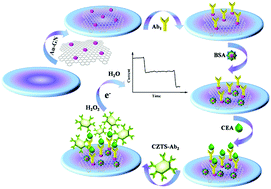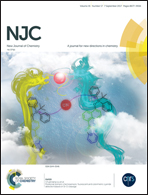A novel sandwich-type immunosensor based on three-dimensional graphene–Au aerogels and quaternary chalcogenide nanocrystals for the detection of carcino embryonic antigen†
Abstract
In this work, a sandwich-type electrochemical immunosensor was fabricated for the detection of carcino embryonic antigen (CEA) with the novel label of quaternary chalcogenide nanocrystals – Cu2ZnSnS4. They illustrated efficient intrinsic peroxidase-like activity in the catalytic reduction of peroxide hydrogen, which was ascribed to the synergistic effect of elemental composition in quaternary chalcogenides. Meanwhile, because of a high specific surface and good biocompatibility, three-dimensional Au nanoparticle loaded graphene aerogels were selected as substrates to capture more antibodies (Ab1). Under optimal conditions, the immunosensor exhibited a wide linear range from 0.5 pg mL−1 to 20 ng mL−1 with a low detection limit of 0.15 pg mL−1 (S/N = 3) for CEA detection. In addition, high sensitivity, excellent selectivity, good reproducibility and stability were obtained for the immunosensor. All of these results show that the novel immunosensor has a promising application for the quantitative detection of CEA in clinical diagnosis.



 Please wait while we load your content...
Please wait while we load your content...